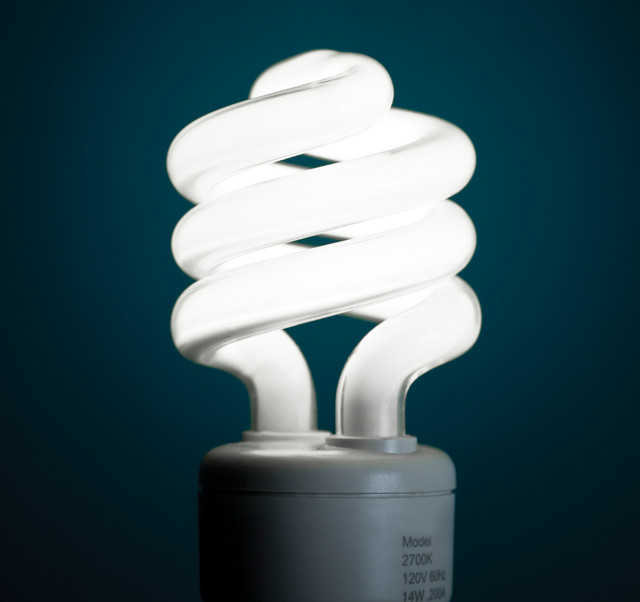
by U.S. Geological Survey Wednesday, June 13, 2018
U.S. Geological Survey tungsten commodity specialist Kim B. Shedd compiled the following information about tungsten, an important metal used in lighting and wear-resistant materials.

Tungsten is used in fluorescent light bulbs. Credit: ©iStockphoto.com/Pgiam/ stock-photo-13986523-fluorescent-light-bulb
Tungsten, sometimes called wolfram, is a metal only found naturally in chemical compounds, such as in the ore minerals wolframite and scheelite. Tungsten has the highest melting point and one of the highest densities of all metals. When combined with carbon, it forms a compound that is almost as hard as diamond. These and other properties make it useful in a wide variety of important commercial, industrial and military applications.
Although lamp filaments in incandescent and halogen bulbs may be the most familiar use of tungsten, the leading use is in cemented carbides. More than half of all tungsten is used to make cemented carbides, or “hardmetals,” which are made by pressing and sintering tungsten carbide particles in a binder matrix of cobalt metal powder. The resulting wear-resistant parts are used in tools and equipment by the construction, metalworking, mining, and oil and gas drilling industries.
About a quarter of tungsten consumption occurs in the production of high-speed and other steels for cutting, forming and working metal, as well as high-density alloys and corrosion- and wear-resistant alloy parts and coatings. Tungsten metal contacts, electrodes and wires are used for a variety of applications. Tungsten, often in combination with less-dense materials, can also be used as a substitute for lead in ammunition, fishing weights and hunting shot. Chemical uses of tungsten include catalysts, dyes and pigments, fire-resistant compounds, lubricants and semiconductor manufacturing.
Demand for tungsten tends to follow general economic conditions and industrial activity. During the past decade, the growth in China’s economy has resulted in a significant increase in Chinese consumption of tungsten raw materials to produce downstream products for its domestic market, such as cemented carbide tools.
China is also the world’s dominant source of mined tungsten and has been for most of the last 100 years. Since the late 1990s, the Chinese government has increased control over its tungsten industry to conserve its resources and ensure that domestic supplies meet anticipated demand. This control has included regulating the production of tungsten concentrates through mine closures and production quotas along with regulating tungsten exports by issuing export licenses and restricting the volumes and types of tungsten materials and products that could be sent out of the country. China has shifted toward exporting value-added downstream tungsten materials and products instead of tungsten raw materials.
Government stockpiles are important sources of raw materials for the tungsten industry. During the Cold War, large quantities of tungsten materials were stockpiled in the United States and the Soviet Union. Following the breakup of the Soviet Union, some of these materials were released for use by industry. At the end of 2011, nearly 16,000 tons of tungsten remained in the U.S. government’s National Defense Stockpile.
For more information on tungsten and other mineral resources, visit: http://minerals.usgs.gov/minerals.
Tungsten production and consumption
In 2011, estimated worldwide production was 72,000 metric tons of tungsten in concentrates.
The world’s largest producer and consumer of tungsten is China, which accounted for 83 percent of estimated worldwide tungsten concentrate production in 2011.
Austria, Bolivia, Canada, Portugal and Russia are the other leading producers of tungsten.
High prices from 2004 through 2011 led to new mine development and work toward reopening inactive mines worldwide.
In 2011, an estimated 30 to 40 percent of the world’s supply of tungsten came from recycled materials.
The name “tungsten” is from the Swedish “tung sten” or “heavy stone.”
W, the chemical symbol for tungsten, is from “wolfram,” a common name of German origin for tungsten.
Fluorescent tubes and compact fluorescent lamps have tungsten electrodes.
The small motors that vibrate mobile phones contain an unbalanced tungsten alloy weight.
Tungsten wires are used to defrost automobile windows.
The rolling tips of ballpoint pens are made from tungsten carbide.
© 2008-2021. All rights reserved. Any copying, redistribution or retransmission of any of the contents of this service without the expressed written permission of the American Geosciences Institute is expressly prohibited. Click here for all copyright requests.